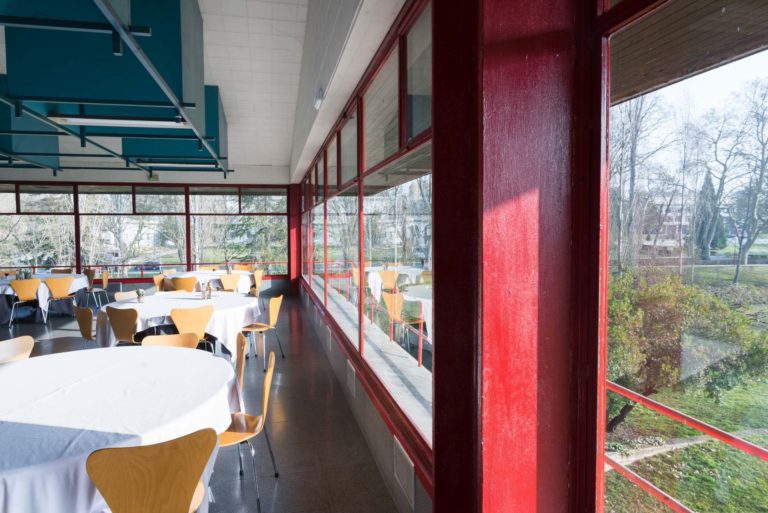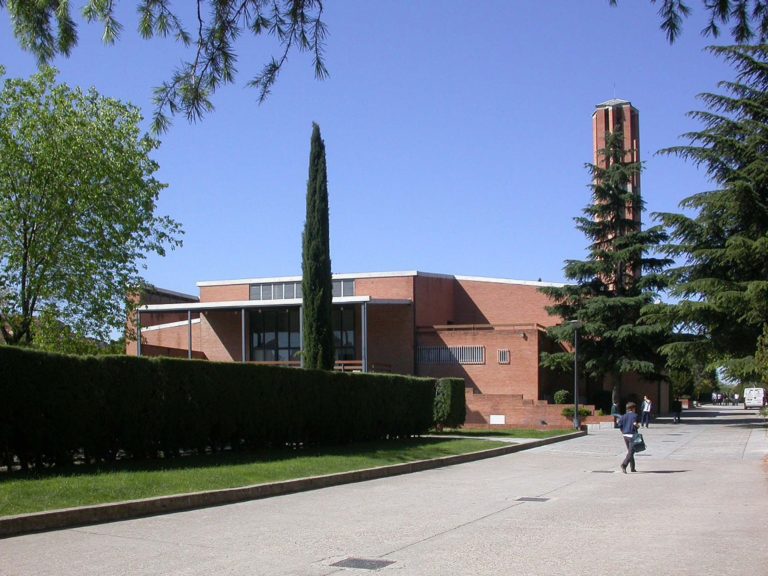Rafael Echaide Itarte
San Sebastián, 1923-Pamplona, 1994
Born in San Sebastian into a family of liberal professionals – his father was an engineer and his grandfather a lawyer – there was no family history of professions tied to art or architecture. However, as a child, Echaide showed an exceptional talent for drawing, which his parents nurtured with private classes. When the time came for him to decide on his professional path, as in so many other cases, drawing led him into architecture.
Following mandatory studies in the exact sciences, he moved to Madrid to begin his training in architecture. After three years, he moved to Barcelona to finish his degree. In Madrid, he had made friends with César Ortiz-Echagüe, which was why he returned to there in 1954, after finishing his studies, with the intention of opening a joint professional office.
Ortiz-Echagüe had begun to receive commissions from the SEAT car company, for which he had partnered with the studio of Manuel Barbero Rebolledo and Rafael de la Joya Castro. These initial projects earned critical acclaim and were published in the international media. Based on this reputation, he was able to open his own studio with Echaide. The continuity of their work for SEAT provided viability for the studio in its early years as their main source of work: they built several buildings in Barcelona, notably one for a laboratory; other commissions for SEAT led them to work in Madrid and Seville. This first group of buildings demonstrated a coherent aesthetic and was highly influenced by Mies van der Rohe’s American buildings made from steel and glass. They felt that architectural language was ideal for providing the image of modernity they wanted to give their SEAT buildings. Their definitive success came with a third building in Barcelona: the cantina for SEAT workers, which received the Reynolds Memorial Award for its innovative use of materials, but above all for its clarity, order and expressive use of a metallic structure. The rationalist and structuralist approach that characterizes the architecture designed by Ortiz Echagüe and Echaide has been labelled by some experts as “technological functionalism.”
The commissions from SEAT were followed by other corporate projects: for example, for Banco Popular, for which they built the central headquarters in Madrid, in addition to branch offices and regional headquarters. In the later years, the studio took on a series of education-related programmes, including the Instituto Tajamar in Vallecas, and the Colegio Retamar in Somosaguas. These school projects were preceded by a theoretical reflection and an attempt to “humanize the spaces.” In reality, the designs were grounded in a knowledge of the most innovative projects on the international scene at the time and, as such, they are considered precursors of the architecture of modern pedagogy in Spain.
The shared studio with Ortiz-Echagüe achieved notable success and was characterized by a modern and efficient structure. Echaide was committed to the excellence of their designs, and, to that end, he developed an internal training course for collaborators in the studio, which he directed. In 1976, the course was published in book form under the title Architecture Is a Historical Reality. The book, Echaide’s main contribution to architectural theory, offers a compendium of lessons about historical and contemporary architectural case studies, always from the perspective of the practice of architectural design. He developed a similar approach in his work as an educator.
Echaide combined his professional practice with teaching, as a professor of architectural design, beginning in 1963. In 1966 he moved to Pamplona, where he also taught design and completed, now on his own, the university cafeteria and the School of Architecture for the University of Navarra, the final projects of his career.
When Echaide died in 1994, Rafael Borobio published an obituary that is one of the best bibliographic resources for learning about his career and his personality. In it, Borobio highlights Echaide’s great humility, his disinclination to advertise or share his professional successes; for that reason, Borobio asserted that “his exceptional stature went unnoticed by those who shared their lives with him”.
Bibliography
- POZO, José Manuel, ed., Los brillantes 50. 35 proyectos, Ministerio de Vivienda, Madrid, 2010.
- “Nuestra trayectoria arquitectónica”, lecture at the ETSA Madrid in POZO MUNICIO, José Manuel, Ortiz-Echagüe en Barcelona, COAC, Barcelona, 2000.
- ECHAIDE, Rafael, POZO, José Manuel, CATALÀ-ROCA, Francesc, Rafael Echaide: arquitecto, 1923-1994, Universidad de Navarra. Escuela Técnica Superior de Arquitectura, Pamplona, 1994.
- BOROBIO, Luís, En recuerdo de D. Rafael Echaide Itarte, Servicio de Publicaciones de la Universidad de Navarra, Pamplona, 1993.
- ECHAIDE, Rafael, La arquitectura es una realidad histórica, Universidad de Navarra, Pamplona, 1976.
- NÚÑEZ, LADEVEZE, Luís, Rafael Echaide y Carlos Ortiz Echague, Artistas Españoles Contemporáneos, Serie Arquitectos, Servicio de Publicaciones del Ministerio de Educación y Ciencia, Madrid, 1973.








